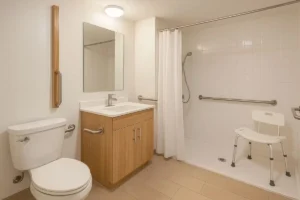Lighting is one of the most important elements in interior design, especially when it comes to accessibility. For people with visual impairments, a well-planned lighting setup can make a huge difference in how they perceive space, move around safely, and maintain autonomy at home. When working with small spaces, the challenge becomes even greater: every inch must be used with purpose, combining functionality, comfort, and visual efficiency. In this article, you’ll discover how to create inclusive and safe lighting for compact spaces, with a special focus on people with low vision.
1. Understanding Different Types of Visual Impairments
Before selecting the ideal solution, it’s essential to understand that visual impairment doesn’t always mean total blindness. Many people with low vision still perceive light, shadow, shapes, and contrast. Some are sensitive to light (photophobia), others may have reduced peripheral vision or difficulty with depth perception.
This means that lighting needs to be adjustable, adaptable, and distributed in a way that respects these different visual needs—avoiding dark corners, excessive glare, or poorly designed contrasts.
2. General Lighting: Uniform and Shadow-Free
General lighting should be wide and evenly distributed. Ceiling-mounted lights with diffusers that emit neutral white light (between 4000K and 5000K) are ideal for offering clarity without glare. The goal is for the entire space—including corners—to be well-lit, avoiding shadow zones that confuse spatial orientation.
In homes with low ceilings, consider recessed lighting, which takes up less space and avoids casting unwanted shadows. LED strips installed in coves or ceiling moldings can also provide indirect, diffuse light that is both efficient and pleasant.
3. Task Lighting for Specific Activities
Small spaces often serve multiple purposes. In addition to general lighting, task lighting is essential for specific activities like reading, cooking, or grooming.
Table lamps with adjustable arms, desk lamps, and wall sconces with directional focus are great allies. What matters is that the light is well-positioned, avoiding direct glare or shadows that interfere with the activity. In kitchens, for example, under-cabinet LED lights brighten countertops directly. In bathrooms, lateral lighting next to mirrors prevents facial shadows and improves visibility.
4. Contrast and Color as Visual Aids
In accessible environments for people with low vision, the contrast between surfaces is just as important as the light itself. When the colors of walls, furniture, and floors blend together, users may struggle to distinguish objects, entrances, or obstacles.
Lighting should enhance these contrasts. A light countertop against dark cabinets, for instance, is easier to detect. Using different colors for walls and floors aids orientation. Light switches and door handles should stand out from the surrounding wall color. Avoid all-white or monochromatic rooms, which diminish depth perception.
5. Natural Lighting: Controlled and Balanced
Natural light is a valuable ally but must be used with care. Too much light can cause glare, while too little can make the environment unsafe. Adjustable blinds, sheer curtains, or window films help filter sunlight without completely blocking it.
The ideal setup directs natural light toward useful areas, such as a reading chair or dining table. During the day, open curtains enhance spatial awareness. At night, transition gently to artificial lighting to avoid discomfort.
6. Color Temperature and Adjustable Intensity
Choosing the right color temperature greatly influences visual comfort. Very cold light (above 6000K) can lead to eye strain and should be avoided in rest areas. Very warm light (below 3000K), on the other hand, may hinder reading or color distinction.
For small, adapted spaces, the ideal is neutral white light between 4000K and 5000K. Additionally, dimmable lights allow the user to adjust brightness according to the time of day, their activity, or their personal sensitivity to light.
7. Automation and Assistive Technology
Home automation can significantly improve daily life for visually impaired individuals, especially in compact environments. Voice control systems, motion sensors, and tactile switches are simple and effective solutions.
Motion-sensor lights that turn on upon entry into a room improve safety and convenience. Virtual assistants like Alexa or Google Home allow users to control lighting without relying on hard-to-find wall switches. Smart bulbs that can be adjusted via smartphone apps provide even greater flexibility and control.
8. Guiding Lights for Nighttime Safety
Small points of light can guide movement during nighttime hours or in dim environments. LED guide lights embedded in baseboards, hallway or stairway marker lights, or plug-in night lights help prevent trips and bumps.
These lighting features should be subtle but effective and always placed strategically—such as beside the bed, near the bathroom, or at doorways.
Final Thoughts
Creating the right lighting in a small space for someone with a visual impairment is a task that requires care, empathy, and technical knowledge. Every detail—from the type of bulb to furniture placement—affects the way the space is perceived and how safe it feels. With proper lighting, well-defined contrasts, and the help of technology, it’s possible to turn a compact room into a warm, functional, and inclusive environment. After all, accessibility is built with light, clarity, and respect for the unique way each person sees the world.

